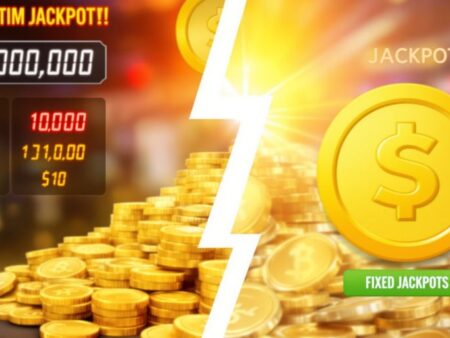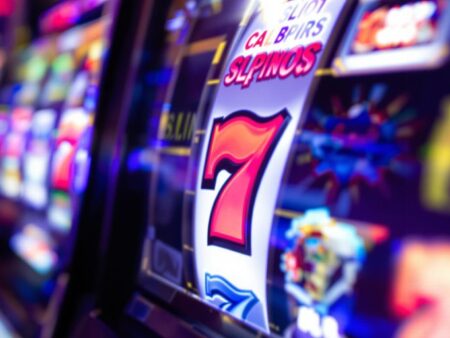So, you’re looking to understand slot machines a bit better, specifically the difference between high volatility and low volatility slots. It can seem a bit confusing at first, with all the talk about risk and payouts. Basically, volatility is just a way to describe how often a slot pays out and how big those wins tend to be. It’s not really about whether a game is good or bad, but more about how it *feels* when you play it. Think of it like this: some games give you lots of little wins often, while others make you wait for a big one. We’ll break down what that means for your gaming sessions.
Key Takeaways
- Volatility in slots refers to how often and how much you win, essentially measuring the risk involved.
- High volatility slots offer bigger payouts but win less often, meaning longer waits between wins.
- Low volatility slots provide more frequent, smaller wins, making them good for longer play sessions.
- RTP (Return to Player) is about long-term payout percentage, while volatility is about the pattern of wins in shorter sessions.
- Choosing the right volatility depends on your personal goals, how much money you have to play with, and what kind of gaming experience you prefer.
Understanding Slot Volatility
What Does Volatility Mean in Slots?
So, what’s this
The Core Difference Between High and Low Volatility Slots
So, you’re wondering about the big difference between high and low volatility slots? It really boils down to how often you win and how much you win when you do. Think of it like this: high volatility games are like waiting for that one big, amazing thing to happen, while low volatility games are more about getting a bunch of little good things regularly. It’s not about which is better, just what fits your mood and your wallet.
High Volatility: Big Wins, Infrequent Payouts
These games are for the patient ones, the dreamers. You might spin for a while, maybe even a good chunk of time, without seeing a significant win. It can feel a bit like a desert sometimes. But when you hit a win, oh boy, it can be a big one. We’re talking about those life-changing amounts, the kind that make you jump out of your seat. It’s a riskier path, for sure. You need a decent bankroll to ride out those dry spells. The potential for massive payouts is the main draw here. If you’re chasing a huge jackpot or just love the thrill of a massive win, high volatility might be your jam. It’s a rollercoaster, and you gotta be ready for the drops.
Low Volatility: Frequent Wins, Smaller Payouts
Now, low volatility slots are the chill ones. You’ll see wins popping up pretty often. It’s a steady stream of smaller wins, like getting a few bucks here and there. This means your bankroll tends to last longer, which is great if you just want to play for a while and have some fun without the stress of big losses. It’s less about hitting the lottery and more about enjoying the game session. These are perfect for casual players or if you’re on a tighter budget. You get that satisfying feeling of winning regularly, even if the amounts aren’t going to make you quit your job. It’s a more relaxed way to play.
The Impact on Your Gaming Session
How does this actually affect your time playing? Well, with high volatility, you might have fewer winning spins, but those wins can be huge. This can lead to longer periods without much action, followed by bursts of excitement. It’s a game of patience and nerve. On the flip side, low volatility means more frequent wins, keeping the action going more consistently. Your balance might not swing wildly, but you’re less likely to see those massive, jaw-dropping payouts. It’s about managing expectations and understanding what kind of experience you’re looking for. Do you want the chance at a massive score, or do you prefer a steady, enjoyable play? Your choice here really shapes the entire feel of your gaming session. If you’re interested in the big wins, you might want to check out some progressive jackpot slots.
| Volatility Type | Win Frequency | Payout Size | Bankroll Impact |
|---|---|---|---|
| High | Low | Large | Requires larger bankroll |
| Low | High | Small | More forgiving on bankroll |
How Volatility Shapes Your Gameplay
So, how does slot volatility actually change the way you play? It’s a pretty big deal, honestly. Think about it: are you the type of person who likes to chase that one massive win, even if it means a lot of spins without much happening? Or do you prefer a more steady stream of smaller wins that keep the game going and your spirits up? That’s where volatility really comes into play.
The Thrill of the Chase: High Volatility
If you’re drawn to high volatility slots, you’re probably someone who enjoys a bit of a gamble, a real thrill-seeker. These games are like rollercoasters. You might have to endure some pretty long stretches where nothing much happens, maybe just a few small wins here and there. It can feel like you’re just spinning and spinning with no real payoff. But then, BAM! You hit a big one. It’s that potential for a huge payout that keeps you hooked. This kind of play requires patience and a bankroll that can handle those inevitable dry spells. It’s not for the faint of heart, but the rewards can be pretty spectacular when they finally land.
Steady Wins for Casual Players: Low Volatility
On the flip side, low volatility slots are more your speed if you like a more relaxed gaming experience. These games are designed to give you wins more often, but they’re usually smaller amounts. It’s like getting a steady trickle of cash rather than waiting for a flood. This makes your money last longer, and you get that satisfying feeling of winning more frequently. It’s a great way to just enjoy the game, maybe chat with friends, or just unwind without the stress of potentially losing your entire balance in a few spins. It’s a safer bet, really.
Balancing Risk and Reward: Medium Volatility
And then there are the medium volatility slots. These try to offer a bit of both worlds. You won’t have to wait as long for wins as you would with high volatility games, and the wins tend to be a bit bigger than what you’d get with low volatility slots. It’s a nice middle ground. You get a decent amount of action, with a reasonable chance of hitting some decent payouts without the extreme swings. Many players find this level to be the sweet spot, offering a good balance between excitement and consistency. It’s a good way to get a feel for different types of slot experiences without committing to the extremes.
Volatility Versus RTP: A Crucial Distinction
It’s easy to get confused between volatility and RTP when you’re looking at slot games. They sound like they should be related, right? But they actually tell you different things about how a game plays out. Think of it like this: RTP is the long game, and volatility is the short game, how it feels right now.
Defining RTP: Long-Term Payout Percentage
RTP, or Return to Player, is basically a theoretical number. It tells you, over a really, really long time, how much of the money bet on a slot machine is supposed to come back to players. So, if a slot has a 96% RTP, it means that for every $100 wagered, about $96 is paid back out. This is a statistical average, though. It doesn’t mean you’ll get $96 back every time you put $100 in. It’s more like a marathon runner’s average pace, not what they do on every single mile. You can find out a slot’s RTP by checking reviews or sometimes in the game’s info screen. It’s a good way to gauge the overall fairness of a game, but it won’t tell you if you’re going to win big today.
Defining Volatility: Payout Frequency and Size
Volatility, on the other hand, is all about the pattern of those payouts. It’s about how often you win and how big those wins tend to be. A high volatility slot might give you small wins pretty often, or it might go a long time without any wins at all, and then suddenly drop a huge payout. Low volatility slots usually give you smaller wins more frequently. It’s like the difference between getting a bunch of small gifts throughout the year versus one really big gift on your birthday. This is what really shapes your actual gaming session. If you’re playing on a mobile casino, you’ll notice this difference pretty quickly.
How RTP and Volatility Interact
Here’s where it gets interesting. You can have two slots with the exact same RTP, say 96%, but they can feel totally different because of their volatility. Slot A (low volatility) might pay out small wins every few spins, keeping your balance steady. Slot B (high volatility) could have you spinning for ages with nothing, then BAM! A massive win that makes up for all those dry spells. It’s wild.
| Feature | RTP (Return to Player) | Volatility |
|---|---|---|
| What it is | Long-term payout percentage | Payout frequency and size |
| Focus | Theoretical returns over time | How the game feels during a session |
| Impact | Overall game fairness | Player experience, risk, and win patterns |
| Example | 96% means $96 returned per $100 wagered | High: infrequent, large wins; Low: frequent, small wins |
So, while RTP gives you a general idea of the game’s long-term payout potential, volatility tells you how you’re likely to experience those payouts during your actual playtime. It’s important to know both to pick a game that fits what you’re looking for, whether that’s steady wins or the chance for a massive jackpot. Understanding this difference really helps manage your expectations and your bankroll, especially if you’re trying out something new like crypto slots.
Choosing the Right Volatility Level for You
Picking the right slot volatility level really comes down to what you’re hoping to get out of your gaming session. It’s not a one-size-fits-all deal, you know? Think about what you want from the game, how much risk you’re comfortable with, and what your budget looks like. It’s like choosing what kind of movie to watch – are you in the mood for an action-packed blockbuster or a quiet drama?
Aligning Volatility with Your Gaming Goals
So, what’s the main goal here? Are you chasing that one massive win that could change everything, or are you more about enjoying a steady stream of smaller wins that keep the fun going for longer? If you’re aiming for those huge jackpots, you’ll probably lean towards high volatility slots. Just be ready, because those big wins don’t show up every day. On the flip side, if you just want to relax and have a good time with wins happening more often, even if they’re small, then low volatility is your friend. It’s about matching the game’s payout style to your personal objectives.
Considering Your Bankroll Size
Your bankroll is super important when deciding on volatility. High volatility games can be pretty unforgiving. You might go through several spins without hitting anything significant, which can eat into your funds pretty quickly. If you have a smaller bankroll, playing these can be risky. Low volatility slots, however, tend to be kinder to your wallet. They give you more frequent wins, which helps your money last longer, making for a more extended play session. It’s a good idea to have a bigger bankroll if you’re going to tackle those high-risk, high-reward games.
Matching Volatility to Your Personality
Honestly, it’s also about your personality and what kind of thrill you enjoy. Some people love the suspense and the potential for a massive payout, even if it means enduring some dry spells. That’s the high volatility player. They get a kick out of the chase. Then there are players who prefer a more predictable experience. They like seeing wins come in regularly, even if they’re modest. This steady flow of smaller wins can be really satisfying and less stressful. It’s about knowing yourself and what kind of gaming experience makes you happy. There’s no right or wrong answer, just what feels best for you.
Factors Influencing Volatility Choices
Risk Tolerance and Player Preference
So, you’re trying to figure out which slot volatility is best for you. It really comes down to what kind of player you are. Are you someone who likes a bit of a thrill, maybe even a bit of a gamble, and you don’t mind waiting for that big payoff? If that sounds like you, then high volatility slots might be your jam. They can be a bit of a rollercoaster, but when you hit a good win, it can be pretty sweet. On the flip side, if you’re more of a casual player, someone who just wants to have a good time, maybe extend your playtime with your current budget, and you’re happy with smaller, more frequent wins, then low volatility slots are probably more your speed. It’s all about what makes your gaming session enjoyable. There’s no right or wrong answer here, just what feels good to you.
The Role of Your Budget
Let’s talk about the money, because that’s a big part of it. If you’ve got a smaller bankroll, playing high volatility slots can be pretty tough. You might go through a lot of spins without seeing a decent win, and that can eat into your funds pretty quickly. It’s like trying to climb a mountain with no snacks – you might get there, but it’s going to be a struggle. Low volatility slots, though, they’re usually much kinder to your wallet. You get more wins, more often, which helps your money last longer. So, if you’re on a tighter budget, or you just want to make your money go further, sticking with lower volatility games is a smart move. It’s not about being scared to play; it’s about playing smart.
Understanding Your Playing Style
Think about how you like to play. Do you get excited by the possibility of a massive jackpot, even if it means enduring long stretches without a win? That’s the high volatility experience. It’s a game of patience and nerve. Or do you prefer a more consistent, steady stream of smaller wins that keep the game moving and your spirits up? That’s the low volatility way. It’s less about the huge score and more about the journey. Some people like the tension of waiting for that big bonus round, while others just want to enjoy the game without too much stress. Knowing whether you’re a thrill-seeker or a steady player really helps narrow down your choices. It’s like picking between a fast roller coaster and a gentle Ferris wheel – both are fun, but in very different ways.
Navigating High Volatility Slot Experiences
Playing high volatility slots can feel like a rollercoaster, and honestly, it’s not for everyone. You’re chasing those big wins, the ones that make your heart pound, but you’ve got to be ready for the quiet times. Those can be long. It’s like waiting for a bus that’s always late, but when it finally shows up, it’s a limo. You need patience, a good chunk of change to keep spinning, and a mindset that doesn’t get too bummed out by a few hundred spins without a decent return. It’s a gamble, for sure, but the potential payoff is what draws people in. You’re not just playing for a small win; you’re playing for the win.
The Potential for Explosive Rewards
This is the main draw, right? High volatility games are built to offer those massive payouts. Think of hitting a jackpot or a huge multiplier during a bonus round. These moments are rare, but when they happen, they can be truly spectacular. It’s the dream of turning a small bet into a life-changing amount. The game mechanics are often designed to build up to these big moments, making the anticipation part of the fun. It’s a thrill that low volatility games just can’t replicate.
Managing Longer Dry Spells
Okay, so here’s the flip side. Those big wins don’t come around every day, or even every session. You’ll likely experience periods where you’re just not winning much, or anything at all. This is where your bankroll management and mental game really come into play. Don’t get discouraged. It’s part of the deal with these types of slots. Think of it as an investment; you’re putting in the time and money, hoping for a big return later. Staying calm and sticking to your budget is key. Maybe lower your bet size during these times to make your money last longer.
The Need for a Larger Bankroll
Because of those long dry spells, you absolutely need more money to play high volatility slots compared to their low volatility cousins. If you only have a small amount to play with, you’ll likely run out of funds before you hit any significant wins. It’s not uncommon to need several hundred spins to trigger a bonus feature or land a decent payout. So, if you’re planning to tackle these games, make sure your bankroll can handle the swings. A good rule of thumb is to have enough to cover at least 200-300 bets, but more is always better. This gives you a fighting chance to ride out the inevitable losing streaks and actually reach those potentially big wins.
Embracing Low Volatility Slot Experiences
Enjoying Consistent Smaller Wins
Low volatility slots are your best friend if you like seeing wins pop up pretty regularly. You won’t hit a massive jackpot every other spin, but you’ll get those smaller wins that keep the game moving and your balance from totally tanking. It’s like a steady stream of little victories, which can be really satisfying. You get that nice feeling of progress without the gut-wrenching drops you sometimes get with high volatility games. It’s a more relaxed way to play, honestly.
Extending Your Playing Sessions
Because the wins are more frequent and usually smaller, low volatility slots are fantastic for making your bankroll last. If you’ve only got a little bit of cash to play with, or you just want to enjoy the game for a longer time, these are the ones to pick. You can spin for ages, soaking in the atmosphere and enjoying the gameplay without constantly worrying about running out of money. It’s a great way to just chill out and have some fun for a while.
A Safer, Less Risky Option
Let’s be real, not everyone wants to gamble with their rent money. Low volatility slots are definitely the way to go if you’re more cautious or just want to play for entertainment without too much stress. The risk of losing a big chunk of your money quickly is way lower. You’re not chasing those huge, life-changing wins, but you’re also not staring at a blank screen for hours on end. It’s a balanced approach, giving you a good chance to win something without putting yourself out there too much. It’s just a more chill way to experience slot machines.
Identifying Slot Volatility Levels
So, you want to figure out if a slot game is going to hit you with a flurry of small wins or make you wait ages for that one big score. It’s not always obvious, but there are definitely ways to get a handle on it. Think of it like trying to guess the weather; you can look at the clouds, check the forecast, or just go outside and feel it. Slot volatility is kind of the same.
Common Volatility Classifications
Most games fall into a few main categories. It’s not an exact science, but it gives you a good idea:
- Low Volatility: These are the chill ones. Expect frequent wins, but they’re usually pretty small. Good for stretching your playtime and keeping things steady. You won’t get rich quick, but you probably won’t go broke fast either.
- Medium Volatility: This is the middle ground. Wins happen reasonably often, and the payouts can be a bit more interesting than low volatility slots. It’s a nice balance for many players who want a bit of excitement without too much risk.
- High Volatility: Get ready for the rollercoaster! Wins are rare, but when they do hit, they can be massive. This is for players who have patience and a bigger bankroll, hoping for that one huge payout. You might have long stretches with no wins, though.
Some games even throw in "medium-low" or "high-medium" classifications, so it’s a bit of a spectrum, not just three strict boxes. It’s like saying some days are just "a bit cloudy" instead of "raining" or "sunny."
Where to Find Volatility Information
Okay, so how do you actually find this info? It’s not always plastered on the front of the machine or the game screen, but there are a few places to look:
- The Game’s Info Button: Almost every slot game has an information icon (often an ‘i’ or a question mark). Click that! It usually details the paytable, bonus features, and often, the volatility level. This is your best bet, seriously.
- The Game Developer’s Website: The companies that make the games usually list the volatility for each slot on their own sites. If you know the game you like, a quick search can often tell you.
- Online Slot Review Sites: Many gaming websites and blogs review slots and will explicitly state the volatility. Just search for the game name plus "volatility review."
Don’t just guess; take a minute to check. It can save you a lot of frustration.
Using Slot Demos to Assess Volatility
Sometimes, the best way to know is to just play. Many online casinos offer demo versions of their slot games. This means you can play with fake money, which is perfect for testing the waters.
Here’s how you can use demos to get a feel for volatility:
- Play for a Set Number of Spins: Pick a number, say 50 or 100 spins, and see how many times you win and what the average win size is. If you get lots of small wins, it’s likely low volatility. If you get very few wins, but one or two are decent, it’s probably higher volatility.
- Observe Your Bankroll: How quickly does your fake money go down? If it depletes rapidly with few wins, that’s a sign of high volatility. If it stays relatively stable, even with small wins, it’s leaning towards low volatility.
- Look for Big Wins: Did you hit any significant payouts during your demo session? If the biggest wins came from rare combinations or bonus rounds, that’s a hallmark of high volatility games. Small, frequent wins are the opposite.
It takes a little time, but playing a demo is a great way to get a feel for a game’s rhythm before you commit your real cash. It’s like test driving a car before you buy it, you know?
The Impact of Volatility on Slot Payouts
So, how does slot volatility actually mess with the money you win? It’s all about the rhythm of the wins, you know? Think of it like this: high volatility slots are like waiting for that one big score, while low volatility ones are more like getting a bunch of small treats. You might not see a huge difference in just one or two sessions, but over time, the pattern really shows itself.
How Volatility Affects Win Frequency
This is where things get interesting. High volatility games are stingy with wins. You could spin for ages, and nada. But when a win finally pops up, it’s usually a decent amount. Low volatility slots, on the other hand, are way more generous with payouts. You’ll see wins popping up pretty often, but they’re typically smaller amounts. It’s a trade-off, really.
- High Volatility: Expect fewer wins, but when they happen, they tend to be larger.
- Low Volatility: Expect more frequent wins, but these are usually smaller.
- Medium Volatility: A mix of both, trying to balance frequency and size.
The Size of Payouts in Different Volatility Games
When we talk about the size of payouts, volatility plays a massive role. High volatility slots are designed to give you those massive, life-changing wins, but they don’t hand them out easily. The math behind these games means that the potential for a huge jackpot is there, but the odds are stacked against you hitting it frequently. Conversely, low volatility slots focus on smaller, more manageable wins. These games are built for players who want to extend their playtime and enjoy a more consistent stream of smaller wins. It’s not about hitting one giant prize; it’s about accumulating smaller wins over time. You can explore free slots with bonus features to get a feel for these different payout structures without any risk. play risk-free.
Volatility’s Influence on Bonus Features
Bonus rounds are often where the biggest wins hide, and volatility really shines here. In high volatility slots, bonus features, like free spins or pick-and-win games, are often designed to deliver those massive payouts. You might get fewer bonus triggers, but when you do, the potential for a huge return is significantly higher. Think of those bonus rounds where you can re-trigger free spins multiple times or hit a massive multiplier. Low volatility slots also have bonus features, but they tend to be more about extending your playtime or offering smaller, more frequent bonuses. You might get a few extra spins or a small instant win, keeping the game flowing without the massive swings. It’s all about managing expectations and understanding what kind of thrill you’re looking for in your gaming session.
Wrapping It Up: Finding Your Slot Sweet Spot
So, whether you’re chasing those massive jackpots with high volatility slots or prefer a more relaxed session with frequent, smaller wins from low volatility games, the choice really comes down to you. Think about your budget, how much risk you’re comfortable with, and what kind of gaming experience you’re after. There’s no single ‘best’ type; it’s all about matching the game’s rhythm to your own. Keep these differences in mind next time you’re picking a slot, and you’ll likely have a much more enjoyable time at the virtual casino. Happy spinning!
Frequently Asked Questions
What exactly is slot volatility?
Slot volatility, also called variance or risk level, tells you how often a slot machine pays out and how big those wins usually are. Think of it like this: low volatility means you win small amounts more often, while high volatility means you win big amounts less often.
What’s the main difference between high and low volatility slots?
High volatility slots give you the chance for huge wins, but you might go through many spins without winning anything. Low volatility slots pay out smaller wins more frequently, making your money last longer and giving you more chances to win.
How does volatility change how I play?
Volatility affects how exciting your game session will be. High volatility is for players who enjoy the thrill of chasing big wins and don’t mind waiting. Low volatility is great for players who like steady wins and longer playtimes.
What’s the difference between volatility and RTP?
RTP (Return to Player) is a long-term average of how much money a slot pays back over thousands of spins. Volatility is about how often and how big the wins are during your actual playtime. A game can have the same RTP but feel very different depending on its volatility.
How do I pick the right volatility for me?
It really depends on what you’re looking for! If you want the chance at massive payouts and don’t mind the risk, go for high volatility. If you prefer more frequent, smaller wins and want your bankroll to last longer, low volatility is a better choice.
How does my budget affect my volatility choice?
Your budget is a big factor. High volatility slots can be unpredictable and might drain your money faster if you hit a dry spell, so they often need a larger bankroll. Low volatility slots are generally safer for smaller budgets because wins come more often.
How can I find out a slot’s volatility level?
You can often find volatility information in game reviews or sometimes directly in the game’s info section. Many online casinos also let you try demo versions of slots, which is a great way to feel out the game’s volatility before you play with real money.
How does volatility affect the actual payouts?
Volatility influences how often you win and the size of those wins. High volatility means fewer wins, but they’re usually bigger. Low volatility means more wins, but they’re typically smaller. Bonus features can also be designed to pay out differently based on the game’s volatility.























